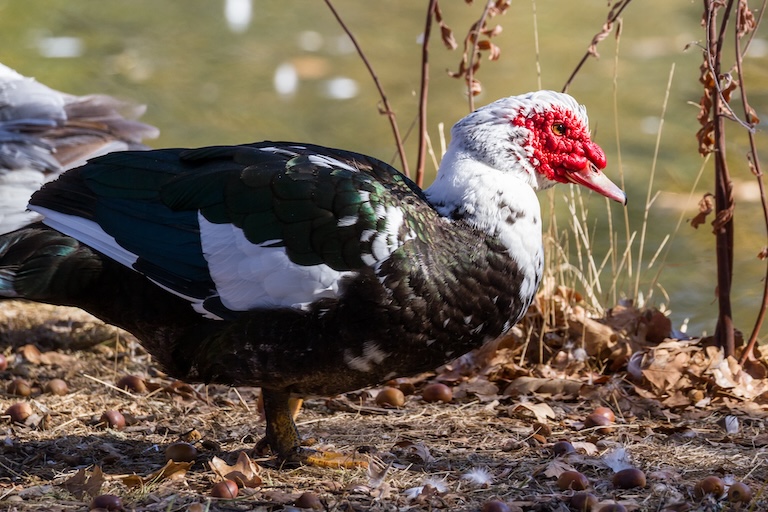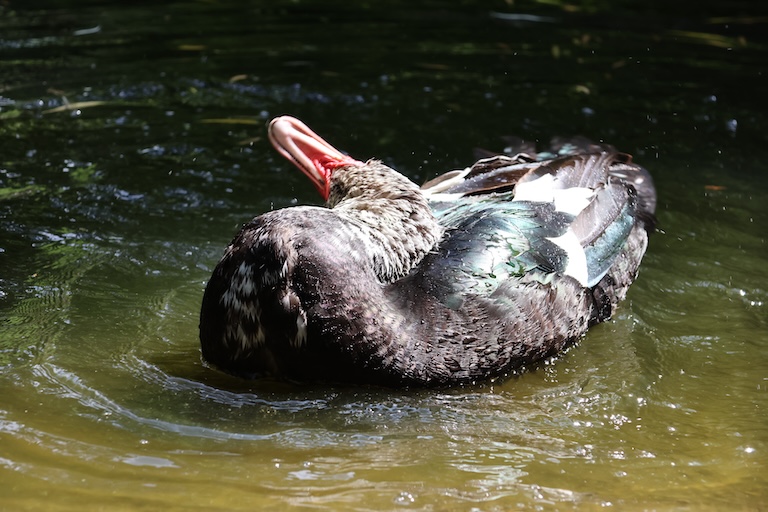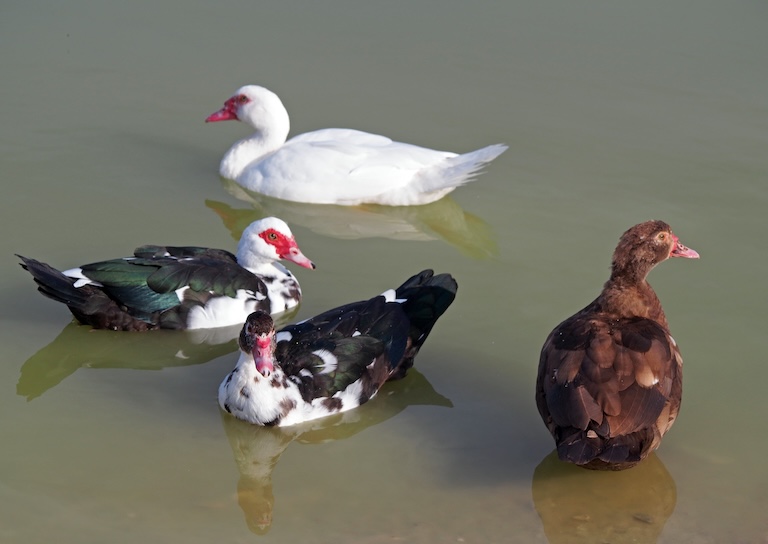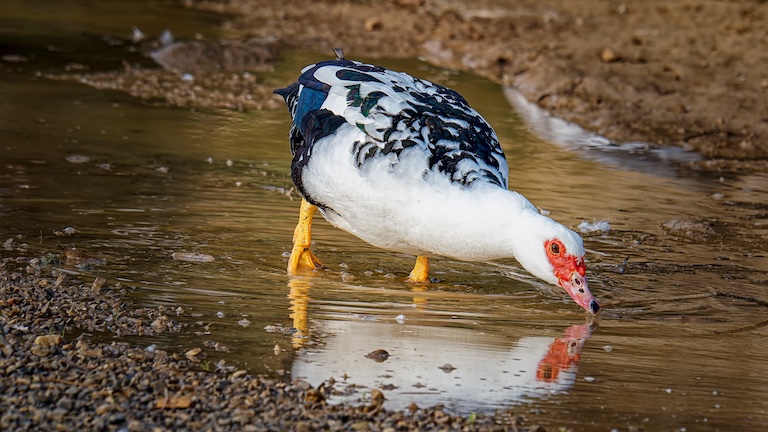Muscovy Duck Profile
As far as dinosaurs go, ducks are generally demure, harmless and cute. But this isn’t always the case; there’s a species from South America who has rejected convention and maintained more of a goosy quality.
It’s huge, aggressive, and well-armed.
The Muscovy duck is a very successful species that has escaped captivity all over the world and will fight anyone who tries to call it cute.

Muscovy Duck Facts Overview
| Habitat: | Forests, near water |
| Location: | Wild in Mexico, Central and South America, domesticated elsewhere |
| Lifespan: | Up to 9 years in captivity, 8 in the wild |
| Size: | Up to 84 cm long |
| Weight: | Up to 6.8 kg |
| Colour: | Brownish-black with iridescent green and purple on the back, white wing patches, red face and wattles |
| Diet: | Plant matter, small fish, reptiles, arthropods |
| Predators: | Racoons, foxes, owls, hawks, herons, alligators, opossums, skunks and minks |
| Top Speed: | Possibly up to 80 km/h (50 mph) |
| No. of Species: | 1 |
| Conservation Status: | Least Concern (IUCN) |
Nobody knows why the Muscovy duck is called what it is, but there’s no denying this bird makes a statement. It comes packing with a heavy body, aggressive tendencies and sharp claws to match.
Females look for males with the best erections and dance moves, and unlike most Anseriformes, this one loves to roost in trees.
Their peculiar habits seem to serve them well, and while they’re native to the Americas, they’ve spread all over the world both as captive and feral populations.
Interesting Muscovy Duck Facts
1. Its name is a bit of a mystery
The obvious explanation would be that it’s named after Moscow, as “Muscovy” is one of the old names for the region around Russia’s capital, but this species isn’t found there and never was.
Various other baseless hypotheses have been thrown about, including that a company which later became named the Muscovy Company, once traded in this breed, but they were unlikely to have traded in anything from the Americas, let alone ducks.
It’s possible that it was just a name given to an animal that was “exotic”, in the way we use Timbuktu, despite having no idea where that actually is. This hypothesis seems most plausible since that’s exactly how turkeys came to be named.
But there’s also a native tribe to Colombia called the Musica, and this species is native to the region, so it’s also possible the name stems from a bastardised version of this. Another contender would be the Miskito Indians, who were known to have domesticated breeds of Muscovy duck.
Regardless of where they come from, though, these ducks have surely managed to get around. 1

2. They’ve spread
Today, variants of this species are found all across the Americas, Eurasia, New Zealand and Australia. Many are domesticated, and lots of populations are now feral. Even Hawaii has a population of Muscovy ducks.
This is one of the oldest domesticated duck species around, so they’ve had plenty of time to explore, and are often spotted in parks and on farms.
They’re still popular as a domestic breed, as a novelty and as a unique flavour of meat. 2
3. They roost in trees
Muscovy ducks differ in a number of ways from most waterfowl, perhaps the most glaring being that instead of sleeping in the water or on the bank, they roost up in trees.
These ducks even nest in tree cavities, which sets them apart again, and both of these habits make them look distinctly out of place, like a rhino laying an egg.
Each year from sexual maturity onwards they’ll breed with a single or multiple partners, but each year they’ll find a new one. And this involves an interesting mating ritual. 3
4. Males twerk and show off their erections
Male Muscovy ducks have a bright crest on their heads which they erect when necessary to show off to other males that they’re the boss.
This flagrant display also works to attract females, who appear to prefer a larger erection when given the choice. Dominant males will also give a butt waggle to seal the deal.
In the wild, they tend towards a lek mating system, and the males with the best crests will get the majority share; most males will be unsuccessful and form support groups of bachelors.
Domestic varieties may pick a single female and stick with her for the season. 4

5. They’re aggressive
These huge ducks are also very powerful and aggressive animals, relative to the docile and shy nature of the common Mallard.
They’re known to aggressively defend themselves and will bite and flap. They can also carry diseases, which adds to the reasons not to wrestle with them, and feral populations can be a bit boisterous, to the point of damaging property.
6. They have claws!
Perhaps the best reason to be careful when in contact with this species is their claws. Claws are also not something we normally associate with waterfowl, but Muscovys have a decent set.
They’re used in fighting and will gauge and scratch opponents while they’re being held down by the beak.
The claws are on the second toe and are large and sharp. With large males hitting 7 kg, this is a duck to be reckoned with, but if you use them right, they can come in handy.
7. They’re great pest control
Their diet can make Muscovy ducks very useful in crop protection.
When set loose among crops they won’t eat or damage, they can get to work clearing up all the various pests such as locusts, flies, snails, grasshoppers and so on.
Along with the large amounts of meat they carry, and their novelty value, this has made them one of the most popular duck species to have around in a domestic setting.

Muscovy Duck Fact-File Summary
Scientific Classification
| Kingdom: | Animalia |
| Phylum: | Chordata |
| Class: | Aves |
| Order: | Anseriformes |
| Family: | Anatidae |
| Genus: | Cairina |
| Species: | moschata |
Fact Sources & References
- “Muscovy Duck”, Cornell Lab.
- “Muscovy Duck”, eBird.
- “Muscovy Duck (Cairina moschata)”, Pero Aves.
- “Cairina moschata Muscovy duck”, Animal Diversity Web.
